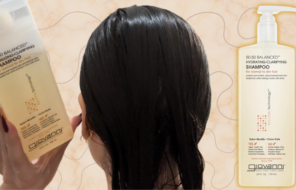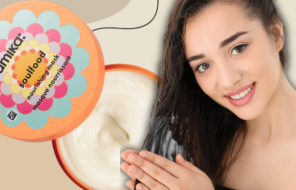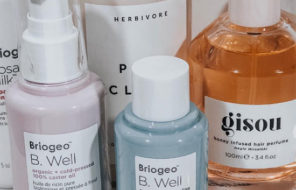Who doesn’t love a head full of sleek, glossy hair free from split ends and breakage? It’s possible to achieve this goal with a little help from a keratin treatment. While usually performed at a salon, you can DIY at home, too.
Although most people think of keratin treatments exclusively for straight or slightly wavy hair types, curly and coily heads can also get in on the action. While it’s still a chemical process, keratin treatments don’t permanently alter your hair’s structure like a traditional relaxer or Japanese hair straightening. Instead, it smoothes your hair by infusing keratin.
If your mane looks like it’s seen better days and those at-home hot oil treatments aren’t cutting it, you might consider a keratin treatment. Whether you have a pro do it for you or give it a go at home, here’s everything you need to know to get the best bang for your buck without damaging your tresses.
Keratin treatments defined
A keratin treatment is a temporary chemical process that coats the hair in liquid keratin protein. The result is glossy, shiny hair that’s soft to the touch and frizz-free. Whether performed in a salon or at home, the treatment is somewhat time intensive and requires following specific instructions to yield the desired results.
Depending on your hair type and other factors, the results can range from straight to looser curl patterns, typically lasting anywhere from two to six months.
Who can get a keratin treatment?
Pretty much anyone with hair can get a keratin treatment. While most people associate it with straight hair and assume only type 1 heads can use it, it’s really for any hair type.
In particular, people who struggle with frizz or have damaged hair from previous chemical processing are ideal candidates. Chemical processing can range from perms and relaxers to bleaching and coloring your hair.
The benefits of keratin treatments
A keratin treatments can offer a variety of benefits for a wide range of hair types, making it an attractive option for many people. Here are some of the ways keratin can help your hair:
- Speeds up styling time. If straight hair and (temporarily) looser curls are your goals, then keratin treatments can help you achieve that without daily heat styling, which can encourage damage.
- Repairs damage. Since the hair is naturally made of keratin, adding additional keratin may improve your hair’s health.
- Works on all hair types. Although individual results vary depending on the intensity of your curl pattern, virtually anyone can benefit from using keratin.
The risks of keratin treatments
As with any process, there are some associated risks or drawbacks to getting a keratin treatment.
- Heat damage. While keratin treatments mean you’ll reach for your heat tools less frequently, they do require a double dose of back-to-back straightening during the process. This can be a lot for fragile hair to take.
- Inconsistent results. This tends to be more of an issue for at-home applications. However, lackluster results are possible if you pick a keratin treatment not formulated to specifically tackle your hair type or concern. Also, note that while the process initially takes two to four hours, it can take up to 72 hours to fully set. During this time, you’ll have to avoid washing your hair, pinning it, or wearing it in a ponytail (to avoid dents).
- Chemical exposure/allergies. Not all keratin treatments contain formaldehyde, but you may not want to be exposed to that particular chemical, along with others. Likewise, if you have a known allergy to any of the treatment’s ingredients, have skin sensitivities, or are pregnant, you should avoid this treatment.
- Overprocessing. Keratin treatments shouldn’t be a go-to solution that you depend on regularly. Attempting too many consecutive keratin treatments can backfire and damage your hair.
The keratin treatment process explained

A keratin treatment infuses the hair (which already contains keratin) with liquid keratin protein. It allows the additional liquid keratin to bond with your hair, strengthening any gaps left by previous damage from over-styling or other chemical processes. Whether at home or in a salon, your treatment will usually follow the below steps:
- Cleansing. You or your stylist should start by washing your hair. The emphasis is on clarifying, as the liquid keratin won’t bond as effectively to dirty hair. Sometimes, you may need to wash your hair multiple times to fully remove dirt or product buildup.
- Applying the keratin. After thoroughly washing your hair, apply the keratin treatment to just your hair — not the scalp.
- Blow drying. Once the hair is completely saturated with the liquid keratin, it’s time to blow dry your hair. Note that the treatment typically contains chemicals with a potent smell, such as formaldehyde, which can “off-gas” when exposed to a direct heat source. So, in most cases, this step needs to be performed in a well-ventilated area. (Wearing a mask can be helpful, too.)
- Flat ironing. To further lock in the smooth, silky hair goals, you’ll end by flat ironing your hair. Again, off-gassing can happen. So be sure to do this in a well-ventilated space.
Keratin vs. other hair treatments
There are a variety of treatments that promise to adjust the texture of your hair or make it more manageable. Below, we show how keratin treatments stack up against other options.
| Treatment | Recommended hair type | Requires heat? | Chemical process? | Alters hair’s structure? | Processing Time |
|---|---|---|---|---|---|
| Keratin | All | Yes: Blow dry + flat iron | Yes | Temporarily | 2-4 hours; 72 hours to fully set |
| Brazilian blowout | Fine/thin hair | Yes: Blow dry + flat iron | Yes | Temporarily | 1-2 hours |
| Japanese hair straightening | All | Yes: Blow dry + flat iron | Yes | Permanently | 3-4 hours; depends on length of hair |
| Chemical relaxer | Types 3-4 | Depends on the desired style | Yes | Permanently | Around 2 hours, depending on hair length |
| Silk press | Types 3-4 | Yes: Blow dry + flat iron | No | Temporarily | 2-3 hours |
Is a keratin treatment right for you?
Ultimately, only you can decide if a keratin treatment is the right option for your hair. However, if you’ve suffered damage from overprocessing or simply want hair that you can quickly style, a keratin treatment can be a good solution. Whether you opt for a professional application or do your keratin treatment at home, be sure to pick the right one for your hair type and the specific issues you need to address, such as dryness or breakage.





